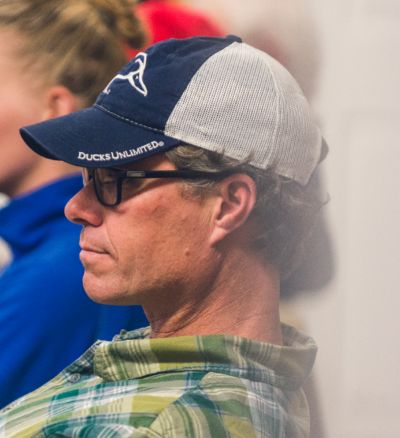Chris Colson, Ducks Unlimited Regional Biologist

Chris Colson, a regional biologist with Ducks Unlimited makes his home in Boise, Idaho but he spends a lot of time in Harney County as an active partner with the Harney Basin Wetlands Collaborative (HBWC). Chris manages a wetland and waterfowl conservation area that encompasses eastern Oregon and southern Idaho. Working with others within Ducks Unlimited as well as local and regional partners Chris works on conserving, restoring and enhancing wetlands like the wetlands of Harney Basin. This work is all-encompassing and incorporates elements of science, planning, policy, advocacy, education and outreach. “My interest in wetlands science and conservation began during my undergraduate time in college. That interest led to graduate research in wetland biogeochemistry in forested wetlands of the South. That forestry work then brought me to Idaho to assist in Boise Cascade Corporation research. I then worked briefly as a BLM botanist which positioned me for an ecologist position with an environmental consulting firm where I began cutting my teeth in wetland restoration and mitigation design. Then it was a short leap to Ducks Unlimited.”
Initially, Chris’ position with Ducks Unlimited was exclusively in southern Idaho but when it expanded to include eastern Oregon, Malheur National Wildlife Refuge had just finished the collaborative drafting of the refuge’s Comprehensive Conservation Plan and there were discussions about the development of HBWC. For Chris, given his role and mission with Ducks Unlimited, collaborating with the HBWI was a no brainer. “HBWI works to maintain, restore, and even increase wetland habitat for migratory waterfowl and waterbirds. Work in the Harney Basin significantly and positively influences waterfowl and waterbird populations at a continental scale. But inherently that work, is made to enhance the agricultural productivity and socioeconomic vitality of Harney Basin producers, restore floodplain functionality for the benefit of stream and groundwater resources and ultimately establish the Harney Basin as a template for conservation-based community revitalization for the Intermountain West and Great Basin.”
An important aspect of maintaining, restoring and increasing wetland habitat is improving flood irrigation infrastructure which in some cases is replacing old, dilapidated dams. Chris has been instrumental in helping dam replacement projects in the Harney Basin happen like the very recent replacement of the Tyler and Sweek dams. As Chris shared: “Every in-stream diversion dam in the Harney Basin is directly responsible for maintaining hydrology across the historical floodplains of the respective stream and river systems. These streams and rivers no longer experience traditional flooding during spring snowmelt. The existing irrigation infrastructure manages the flooding for the benefit of agriculture, but the modification of the stream systems now make them dependent on that infrastructure to distribute surface water across the floodplain and seasonal wet meadow habitat. Nearly all of the in-stream diversion dams in the Harney Basin were installed in the early half of the 20th century and most now exist in a varied state of disrepair like the old Tyler and Sweek dams that were each at least 75 years old.”
Chris works closely with water users to make the reality of new dams possible. As water users consider replacing dams, Chris would like them to know that sometimes things are NOT too good to be true. The HBWI and Oregon Watershed Enhancement Board are truly interested in replacing in-stream diversion dams at NO cost to the water users. The replacement dams are designed to divert full allocations of water rights and are compliant with Oregon Water Resources Department standards. These dams can have at least a 50+ year lifespan and are designed to include the preferred management options of the water users. In some cases there is a need to include fish ladders, but the dams and ladders are designed, under Oregon water law, to continue diverting the full allocated water right, and then any remaining water passing through to be directed through the fish ladder – at no compromise to water right. The state and federal governments, and the respective organizations and agencies, are afforded no rights to the structure and the landowner maintains all of their pre-existing rights under Oregon law.
This may all sound too good to be true but thankfully that’s not the case thanks to funding from the Oregon Watershed Enhancement Board and the work of partners, like Chris, collaborating with the Harney Basin Wetlands Collaborative.

